RMIT BUSM4409 - Business Analysis on Better Buildings Australia Report
VerifiedAdded on 2022/10/06
|12
|3873
|37
Report
AI Summary
This report provides a business analysis of Better Buildings Australia, a family-oriented construction company based in Geelong, Australia. The company, established in 1970, faces challenges due to its traditional management practices and needs to adopt a modern information system. The report investigates the business value proposition of using best-practice information systems, exploring how these systems can improve various functional areas like human resources, sales, marketing, finance, and operations. It emphasizes how project managers can use information systems for scheduling, budgeting, resource management, and communication, ultimately aiming to enhance project completion rates and client satisfaction. The report highlights the importance of adopting technologies to streamline processes, improve data accuracy, and facilitate better client interactions, leading to increased efficiency and a stronger market position for Better Buildings Australia. The report also addresses how information systems can improve delivery-related issues and reduce costs.
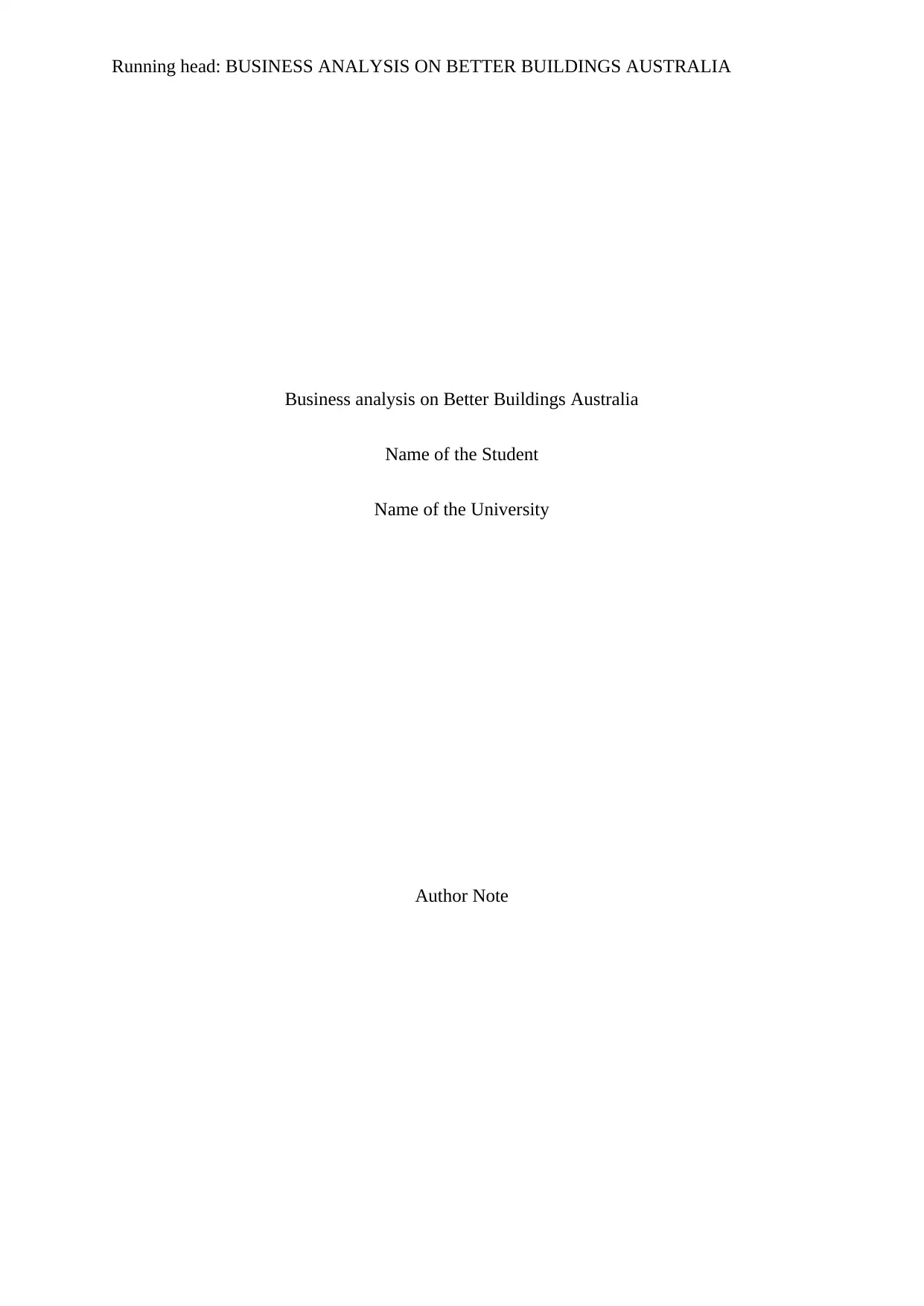
Running head: BUSINESS ANALYSIS ON BETTER BUILDINGS AUSTRALIA
Business analysis on Better Buildings Australia
Name of the Student
Name of the University
Author Note
Business analysis on Better Buildings Australia
Name of the Student
Name of the University
Author Note
Paraphrase This Document
Need a fresh take? Get an instant paraphrase of this document with our AI Paraphraser
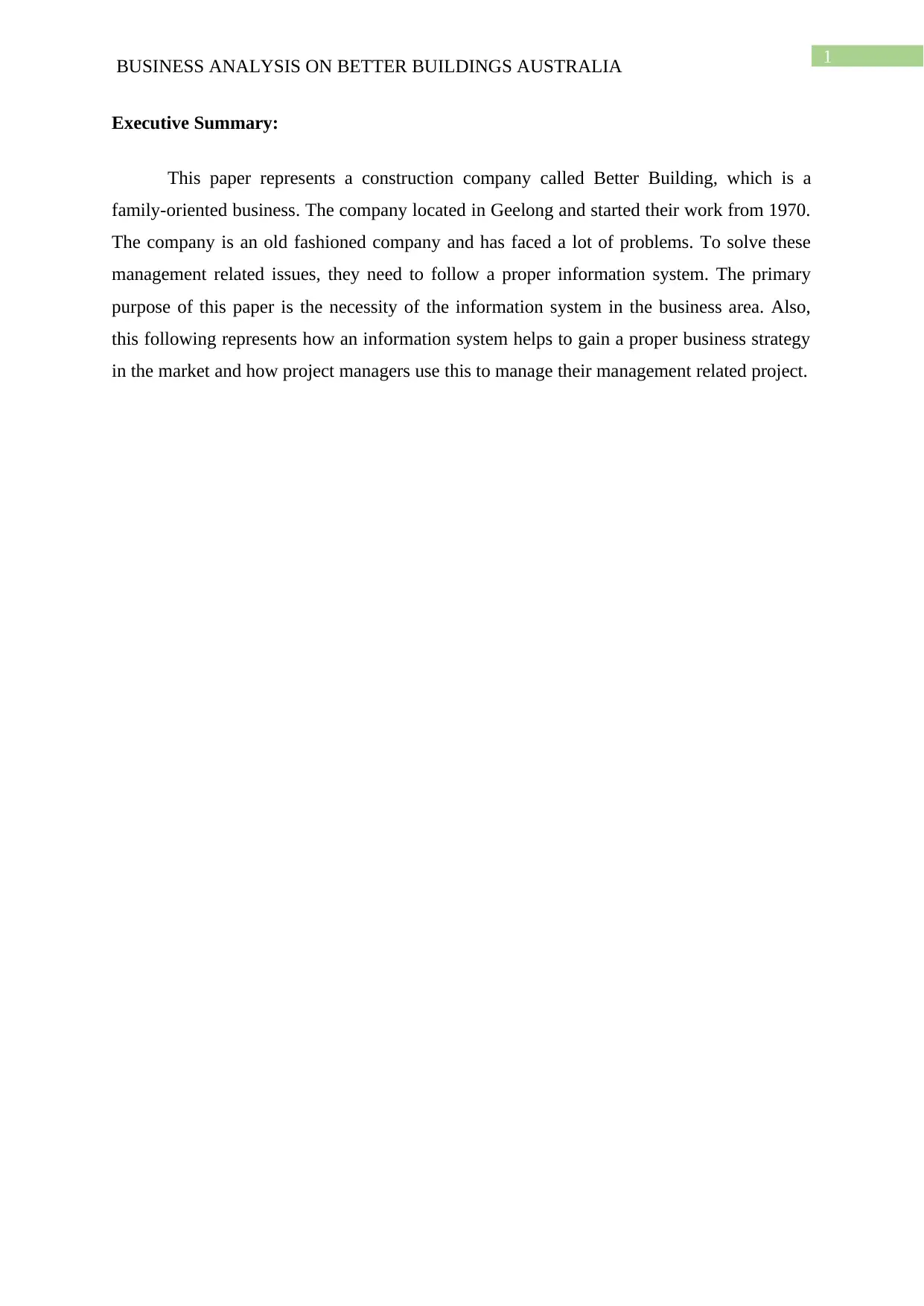
1
BUSINESS ANALYSIS ON BETTER BUILDINGS AUSTRALIA
Executive Summary:
This paper represents a construction company called Better Building, which is a
family-oriented business. The company located in Geelong and started their work from 1970.
The company is an old fashioned company and has faced a lot of problems. To solve these
management related issues, they need to follow a proper information system. The primary
purpose of this paper is the necessity of the information system in the business area. Also,
this following represents how an information system helps to gain a proper business strategy
in the market and how project managers use this to manage their management related project.
BUSINESS ANALYSIS ON BETTER BUILDINGS AUSTRALIA
Executive Summary:
This paper represents a construction company called Better Building, which is a
family-oriented business. The company located in Geelong and started their work from 1970.
The company is an old fashioned company and has faced a lot of problems. To solve these
management related issues, they need to follow a proper information system. The primary
purpose of this paper is the necessity of the information system in the business area. Also,
this following represents how an information system helps to gain a proper business strategy
in the market and how project managers use this to manage their management related project.
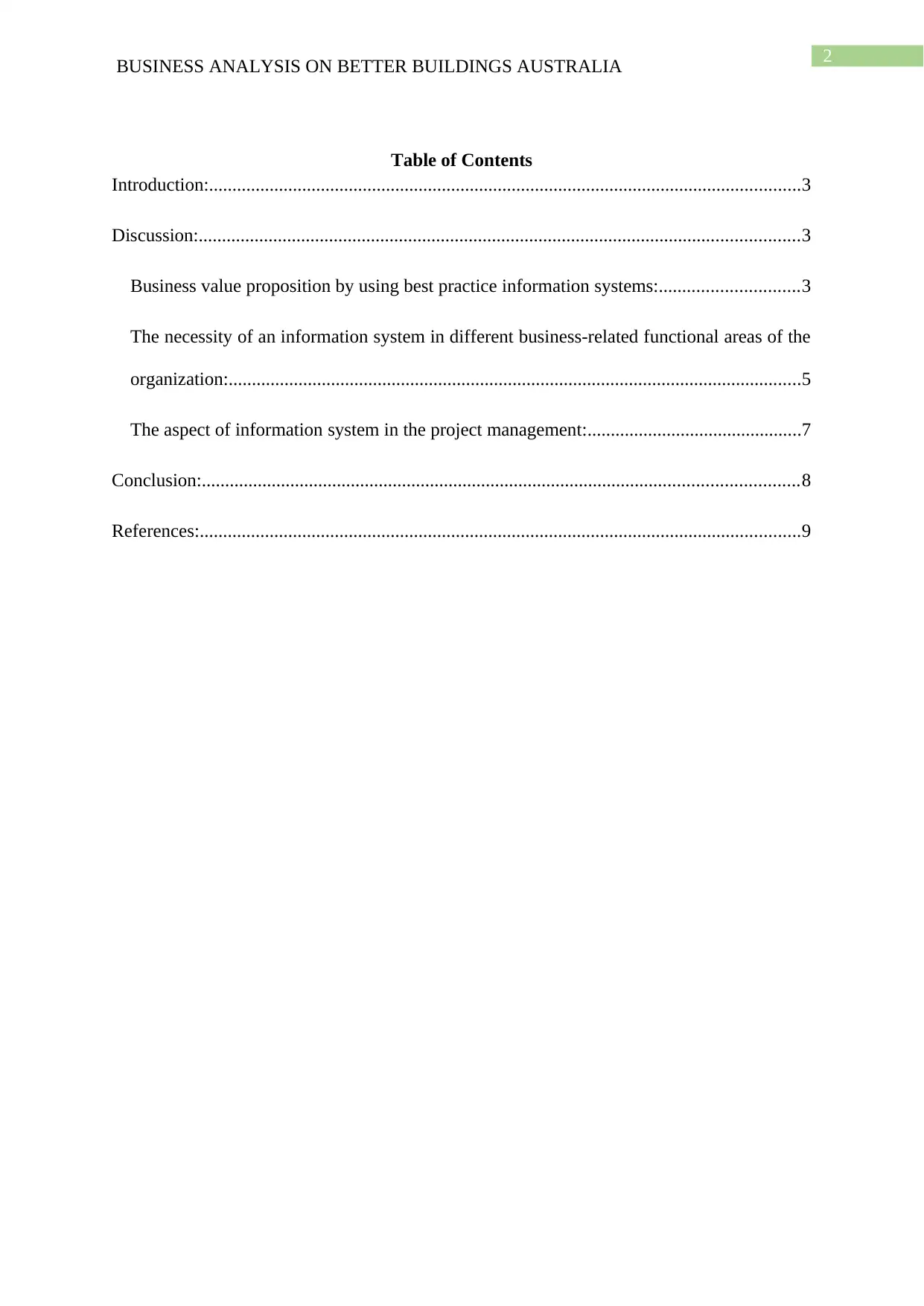
2
BUSINESS ANALYSIS ON BETTER BUILDINGS AUSTRALIA
Table of Contents
Introduction:...............................................................................................................................3
Discussion:.................................................................................................................................3
Business value proposition by using best practice information systems:..............................3
The necessity of an information system in different business-related functional areas of the
organization:...........................................................................................................................5
The aspect of information system in the project management:..............................................7
Conclusion:................................................................................................................................8
References:.................................................................................................................................9
BUSINESS ANALYSIS ON BETTER BUILDINGS AUSTRALIA
Table of Contents
Introduction:...............................................................................................................................3
Discussion:.................................................................................................................................3
Business value proposition by using best practice information systems:..............................3
The necessity of an information system in different business-related functional areas of the
organization:...........................................................................................................................5
The aspect of information system in the project management:..............................................7
Conclusion:................................................................................................................................8
References:.................................................................................................................................9
⊘ This is a preview!⊘
Do you want full access?
Subscribe today to unlock all pages.

Trusted by 1+ million students worldwide
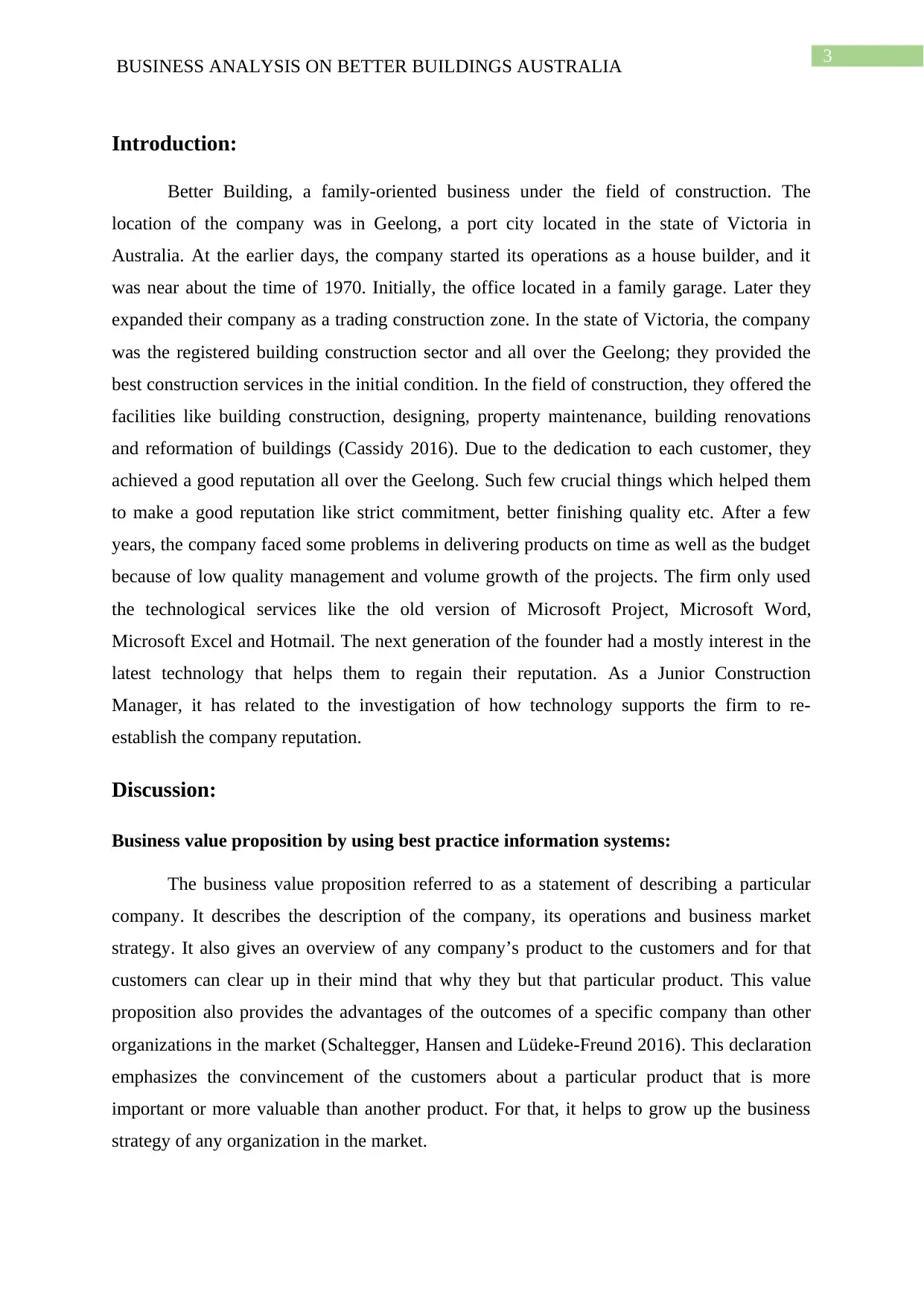
3
BUSINESS ANALYSIS ON BETTER BUILDINGS AUSTRALIA
Introduction:
Better Building, a family-oriented business under the field of construction. The
location of the company was in Geelong, a port city located in the state of Victoria in
Australia. At the earlier days, the company started its operations as a house builder, and it
was near about the time of 1970. Initially, the office located in a family garage. Later they
expanded their company as a trading construction zone. In the state of Victoria, the company
was the registered building construction sector and all over the Geelong; they provided the
best construction services in the initial condition. In the field of construction, they offered the
facilities like building construction, designing, property maintenance, building renovations
and reformation of buildings (Cassidy 2016). Due to the dedication to each customer, they
achieved a good reputation all over the Geelong. Such few crucial things which helped them
to make a good reputation like strict commitment, better finishing quality etc. After a few
years, the company faced some problems in delivering products on time as well as the budget
because of low quality management and volume growth of the projects. The firm only used
the technological services like the old version of Microsoft Project, Microsoft Word,
Microsoft Excel and Hotmail. The next generation of the founder had a mostly interest in the
latest technology that helps them to regain their reputation. As a Junior Construction
Manager, it has related to the investigation of how technology supports the firm to re-
establish the company reputation.
Discussion:
Business value proposition by using best practice information systems:
The business value proposition referred to as a statement of describing a particular
company. It describes the description of the company, its operations and business market
strategy. It also gives an overview of any company’s product to the customers and for that
customers can clear up in their mind that why they but that particular product. This value
proposition also provides the advantages of the outcomes of a specific company than other
organizations in the market (Schaltegger, Hansen and Lüdeke-Freund 2016). This declaration
emphasizes the convincement of the customers about a particular product that is more
important or more valuable than another product. For that, it helps to grow up the business
strategy of any organization in the market.
BUSINESS ANALYSIS ON BETTER BUILDINGS AUSTRALIA
Introduction:
Better Building, a family-oriented business under the field of construction. The
location of the company was in Geelong, a port city located in the state of Victoria in
Australia. At the earlier days, the company started its operations as a house builder, and it
was near about the time of 1970. Initially, the office located in a family garage. Later they
expanded their company as a trading construction zone. In the state of Victoria, the company
was the registered building construction sector and all over the Geelong; they provided the
best construction services in the initial condition. In the field of construction, they offered the
facilities like building construction, designing, property maintenance, building renovations
and reformation of buildings (Cassidy 2016). Due to the dedication to each customer, they
achieved a good reputation all over the Geelong. Such few crucial things which helped them
to make a good reputation like strict commitment, better finishing quality etc. After a few
years, the company faced some problems in delivering products on time as well as the budget
because of low quality management and volume growth of the projects. The firm only used
the technological services like the old version of Microsoft Project, Microsoft Word,
Microsoft Excel and Hotmail. The next generation of the founder had a mostly interest in the
latest technology that helps them to regain their reputation. As a Junior Construction
Manager, it has related to the investigation of how technology supports the firm to re-
establish the company reputation.
Discussion:
Business value proposition by using best practice information systems:
The business value proposition referred to as a statement of describing a particular
company. It describes the description of the company, its operations and business market
strategy. It also gives an overview of any company’s product to the customers and for that
customers can clear up in their mind that why they but that particular product. This value
proposition also provides the advantages of the outcomes of a specific company than other
organizations in the market (Schaltegger, Hansen and Lüdeke-Freund 2016). This declaration
emphasizes the convincement of the customers about a particular product that is more
important or more valuable than another product. For that, it helps to grow up the business
strategy of any organization in the market.
Paraphrase This Document
Need a fresh take? Get an instant paraphrase of this document with our AI Paraphraser
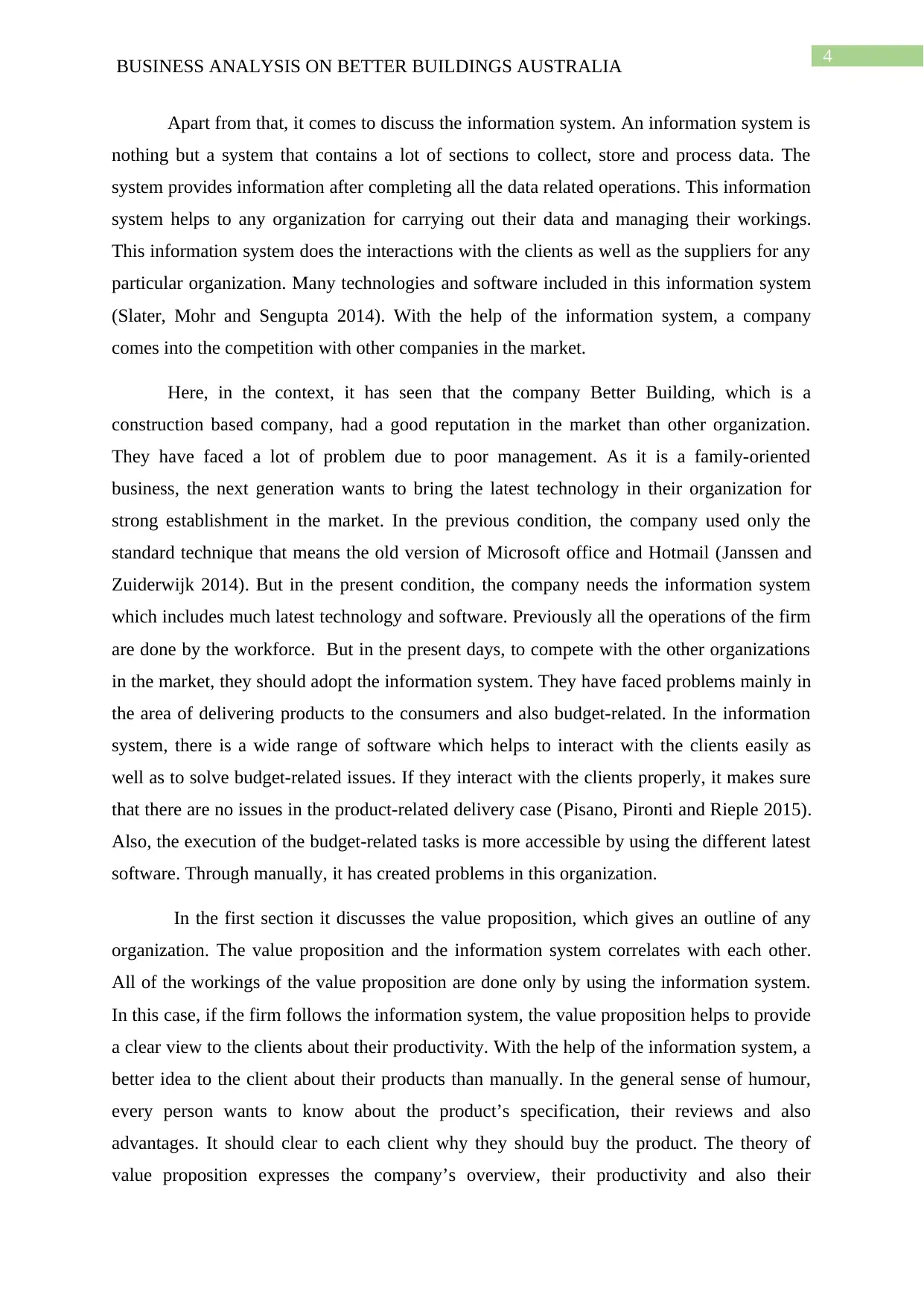
4
BUSINESS ANALYSIS ON BETTER BUILDINGS AUSTRALIA
Apart from that, it comes to discuss the information system. An information system is
nothing but a system that contains a lot of sections to collect, store and process data. The
system provides information after completing all the data related operations. This information
system helps to any organization for carrying out their data and managing their workings.
This information system does the interactions with the clients as well as the suppliers for any
particular organization. Many technologies and software included in this information system
(Slater, Mohr and Sengupta 2014). With the help of the information system, a company
comes into the competition with other companies in the market.
Here, in the context, it has seen that the company Better Building, which is a
construction based company, had a good reputation in the market than other organization.
They have faced a lot of problem due to poor management. As it is a family-oriented
business, the next generation wants to bring the latest technology in their organization for
strong establishment in the market. In the previous condition, the company used only the
standard technique that means the old version of Microsoft office and Hotmail (Janssen and
Zuiderwijk 2014). But in the present condition, the company needs the information system
which includes much latest technology and software. Previously all the operations of the firm
are done by the workforce. But in the present days, to compete with the other organizations
in the market, they should adopt the information system. They have faced problems mainly in
the area of delivering products to the consumers and also budget-related. In the information
system, there is a wide range of software which helps to interact with the clients easily as
well as to solve budget-related issues. If they interact with the clients properly, it makes sure
that there are no issues in the product-related delivery case (Pisano, Pironti and Rieple 2015).
Also, the execution of the budget-related tasks is more accessible by using the different latest
software. Through manually, it has created problems in this organization.
In the first section it discusses the value proposition, which gives an outline of any
organization. The value proposition and the information system correlates with each other.
All of the workings of the value proposition are done only by using the information system.
In this case, if the firm follows the information system, the value proposition helps to provide
a clear view to the clients about their productivity. With the help of the information system, a
better idea to the client about their products than manually. In the general sense of humour,
every person wants to know about the product’s specification, their reviews and also
advantages. It should clear to each client why they should buy the product. The theory of
value proposition expresses the company’s overview, their productivity and also their
BUSINESS ANALYSIS ON BETTER BUILDINGS AUSTRALIA
Apart from that, it comes to discuss the information system. An information system is
nothing but a system that contains a lot of sections to collect, store and process data. The
system provides information after completing all the data related operations. This information
system helps to any organization for carrying out their data and managing their workings.
This information system does the interactions with the clients as well as the suppliers for any
particular organization. Many technologies and software included in this information system
(Slater, Mohr and Sengupta 2014). With the help of the information system, a company
comes into the competition with other companies in the market.
Here, in the context, it has seen that the company Better Building, which is a
construction based company, had a good reputation in the market than other organization.
They have faced a lot of problem due to poor management. As it is a family-oriented
business, the next generation wants to bring the latest technology in their organization for
strong establishment in the market. In the previous condition, the company used only the
standard technique that means the old version of Microsoft office and Hotmail (Janssen and
Zuiderwijk 2014). But in the present condition, the company needs the information system
which includes much latest technology and software. Previously all the operations of the firm
are done by the workforce. But in the present days, to compete with the other organizations
in the market, they should adopt the information system. They have faced problems mainly in
the area of delivering products to the consumers and also budget-related. In the information
system, there is a wide range of software which helps to interact with the clients easily as
well as to solve budget-related issues. If they interact with the clients properly, it makes sure
that there are no issues in the product-related delivery case (Pisano, Pironti and Rieple 2015).
Also, the execution of the budget-related tasks is more accessible by using the different latest
software. Through manually, it has created problems in this organization.
In the first section it discusses the value proposition, which gives an outline of any
organization. The value proposition and the information system correlates with each other.
All of the workings of the value proposition are done only by using the information system.
In this case, if the firm follows the information system, the value proposition helps to provide
a clear view to the clients about their productivity. With the help of the information system, a
better idea to the client about their products than manually. In the general sense of humour,
every person wants to know about the product’s specification, their reviews and also
advantages. It should clear to each client why they should buy the product. The theory of
value proposition expresses the company’s overview, their productivity and also their
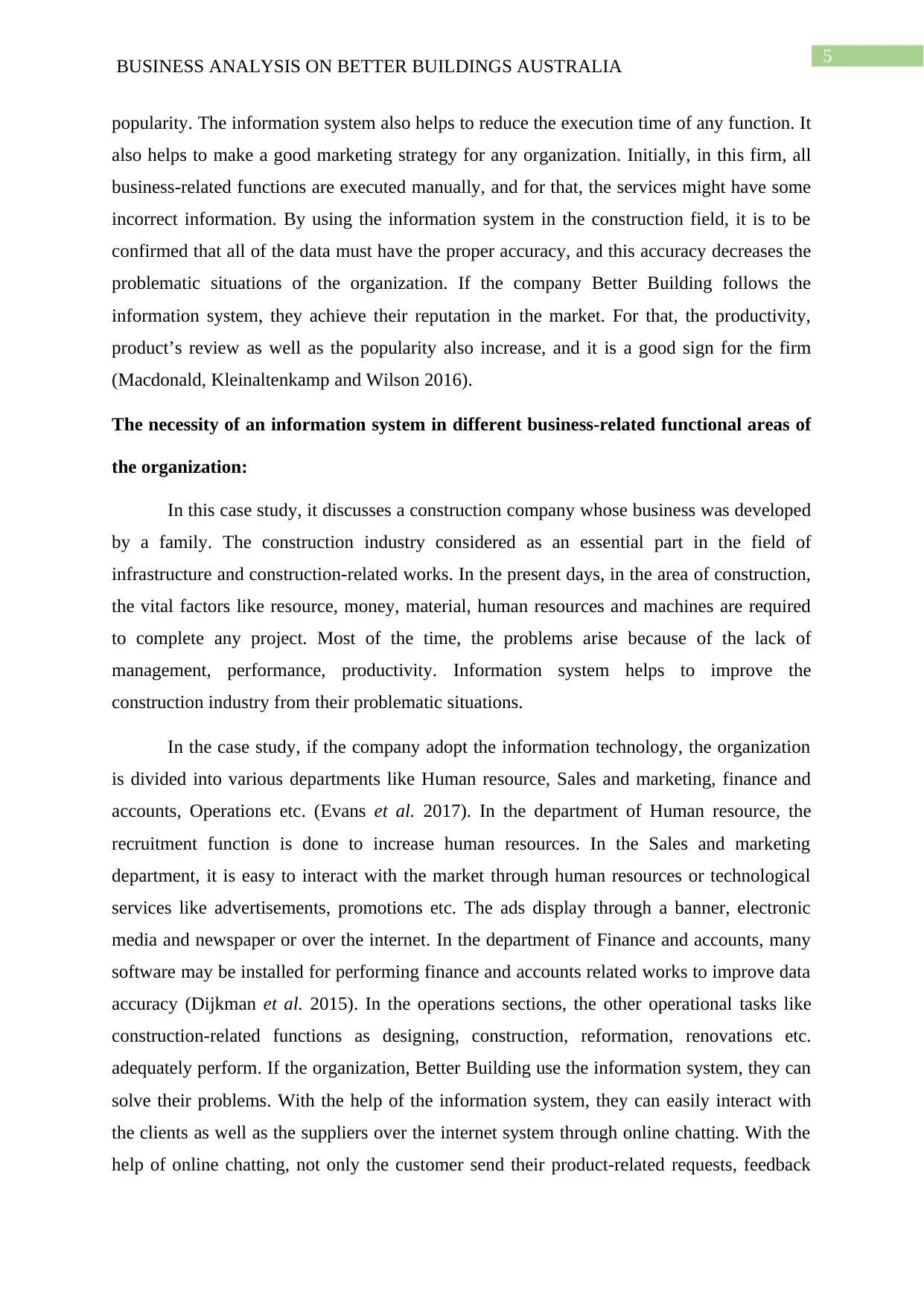
5
BUSINESS ANALYSIS ON BETTER BUILDINGS AUSTRALIA
popularity. The information system also helps to reduce the execution time of any function. It
also helps to make a good marketing strategy for any organization. Initially, in this firm, all
business-related functions are executed manually, and for that, the services might have some
incorrect information. By using the information system in the construction field, it is to be
confirmed that all of the data must have the proper accuracy, and this accuracy decreases the
problematic situations of the organization. If the company Better Building follows the
information system, they achieve their reputation in the market. For that, the productivity,
product’s review as well as the popularity also increase, and it is a good sign for the firm
(Macdonald, Kleinaltenkamp and Wilson 2016).
The necessity of an information system in different business-related functional areas of
the organization:
In this case study, it discusses a construction company whose business was developed
by a family. The construction industry considered as an essential part in the field of
infrastructure and construction-related works. In the present days, in the area of construction,
the vital factors like resource, money, material, human resources and machines are required
to complete any project. Most of the time, the problems arise because of the lack of
management, performance, productivity. Information system helps to improve the
construction industry from their problematic situations.
In the case study, if the company adopt the information technology, the organization
is divided into various departments like Human resource, Sales and marketing, finance and
accounts, Operations etc. (Evans et al. 2017). In the department of Human resource, the
recruitment function is done to increase human resources. In the Sales and marketing
department, it is easy to interact with the market through human resources or technological
services like advertisements, promotions etc. The ads display through a banner, electronic
media and newspaper or over the internet. In the department of Finance and accounts, many
software may be installed for performing finance and accounts related works to improve data
accuracy (Dijkman et al. 2015). In the operations sections, the other operational tasks like
construction-related functions as designing, construction, reformation, renovations etc.
adequately perform. If the organization, Better Building use the information system, they can
solve their problems. With the help of the information system, they can easily interact with
the clients as well as the suppliers over the internet system through online chatting. With the
help of online chatting, not only the customer send their product-related requests, feedback
BUSINESS ANALYSIS ON BETTER BUILDINGS AUSTRALIA
popularity. The information system also helps to reduce the execution time of any function. It
also helps to make a good marketing strategy for any organization. Initially, in this firm, all
business-related functions are executed manually, and for that, the services might have some
incorrect information. By using the information system in the construction field, it is to be
confirmed that all of the data must have the proper accuracy, and this accuracy decreases the
problematic situations of the organization. If the company Better Building follows the
information system, they achieve their reputation in the market. For that, the productivity,
product’s review as well as the popularity also increase, and it is a good sign for the firm
(Macdonald, Kleinaltenkamp and Wilson 2016).
The necessity of an information system in different business-related functional areas of
the organization:
In this case study, it discusses a construction company whose business was developed
by a family. The construction industry considered as an essential part in the field of
infrastructure and construction-related works. In the present days, in the area of construction,
the vital factors like resource, money, material, human resources and machines are required
to complete any project. Most of the time, the problems arise because of the lack of
management, performance, productivity. Information system helps to improve the
construction industry from their problematic situations.
In the case study, if the company adopt the information technology, the organization
is divided into various departments like Human resource, Sales and marketing, finance and
accounts, Operations etc. (Evans et al. 2017). In the department of Human resource, the
recruitment function is done to increase human resources. In the Sales and marketing
department, it is easy to interact with the market through human resources or technological
services like advertisements, promotions etc. The ads display through a banner, electronic
media and newspaper or over the internet. In the department of Finance and accounts, many
software may be installed for performing finance and accounts related works to improve data
accuracy (Dijkman et al. 2015). In the operations sections, the other operational tasks like
construction-related functions as designing, construction, reformation, renovations etc.
adequately perform. If the organization, Better Building use the information system, they can
solve their problems. With the help of the information system, they can easily interact with
the clients as well as the suppliers over the internet system through online chatting. With the
help of online chatting, not only the customer send their product-related requests, feedback
⊘ This is a preview!⊘
Do you want full access?
Subscribe today to unlock all pages.

Trusted by 1+ million students worldwide
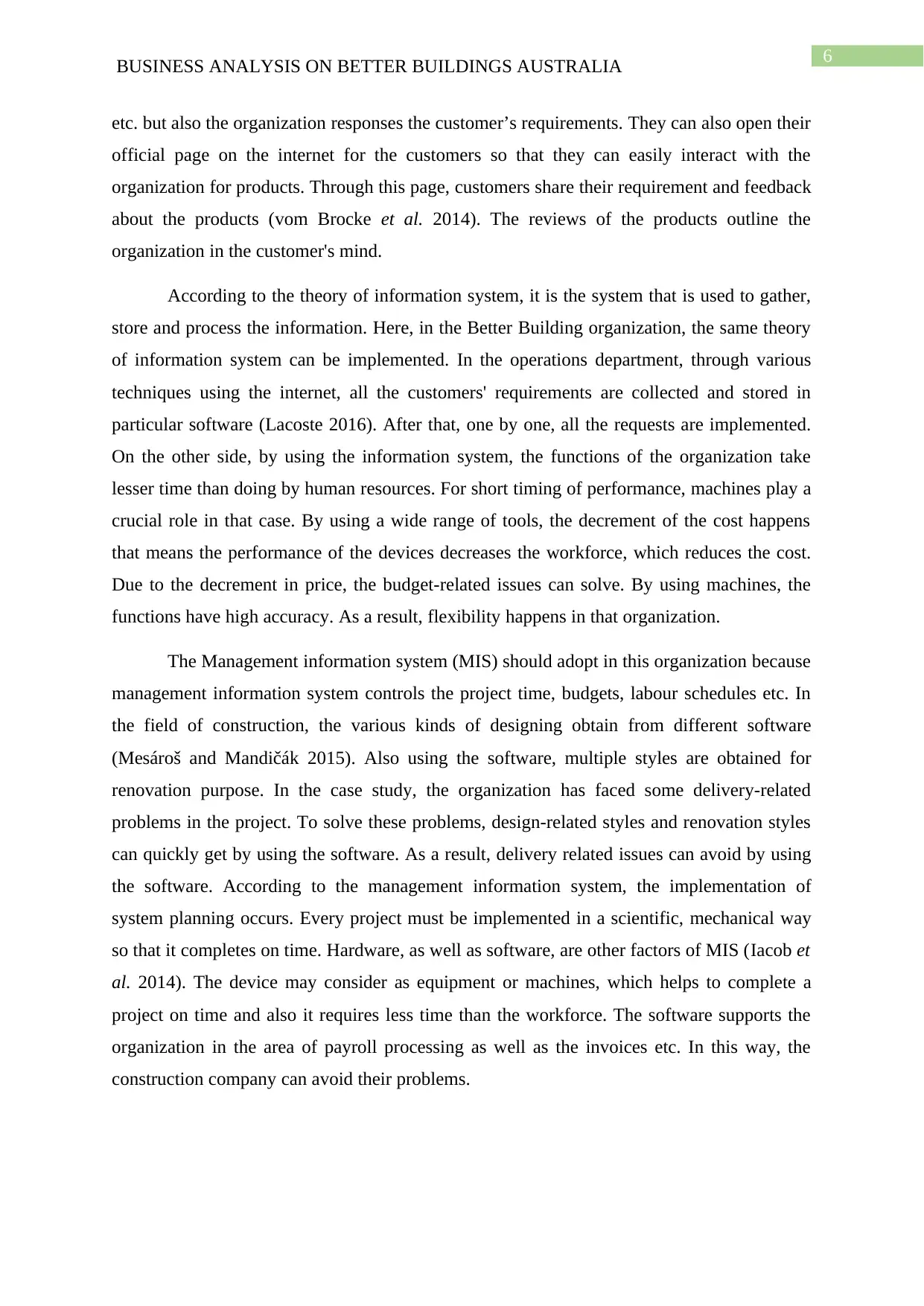
6
BUSINESS ANALYSIS ON BETTER BUILDINGS AUSTRALIA
etc. but also the organization responses the customer’s requirements. They can also open their
official page on the internet for the customers so that they can easily interact with the
organization for products. Through this page, customers share their requirement and feedback
about the products (vom Brocke et al. 2014). The reviews of the products outline the
organization in the customer's mind.
According to the theory of information system, it is the system that is used to gather,
store and process the information. Here, in the Better Building organization, the same theory
of information system can be implemented. In the operations department, through various
techniques using the internet, all the customers' requirements are collected and stored in
particular software (Lacoste 2016). After that, one by one, all the requests are implemented.
On the other side, by using the information system, the functions of the organization take
lesser time than doing by human resources. For short timing of performance, machines play a
crucial role in that case. By using a wide range of tools, the decrement of the cost happens
that means the performance of the devices decreases the workforce, which reduces the cost.
Due to the decrement in price, the budget-related issues can solve. By using machines, the
functions have high accuracy. As a result, flexibility happens in that organization.
The Management information system (MIS) should adopt in this organization because
management information system controls the project time, budgets, labour schedules etc. In
the field of construction, the various kinds of designing obtain from different software
(Mesároš and Mandičák 2015). Also using the software, multiple styles are obtained for
renovation purpose. In the case study, the organization has faced some delivery-related
problems in the project. To solve these problems, design-related styles and renovation styles
can quickly get by using the software. As a result, delivery related issues can avoid by using
the software. According to the management information system, the implementation of
system planning occurs. Every project must be implemented in a scientific, mechanical way
so that it completes on time. Hardware, as well as software, are other factors of MIS (Iacob et
al. 2014). The device may consider as equipment or machines, which helps to complete a
project on time and also it requires less time than the workforce. The software supports the
organization in the area of payroll processing as well as the invoices etc. In this way, the
construction company can avoid their problems.
BUSINESS ANALYSIS ON BETTER BUILDINGS AUSTRALIA
etc. but also the organization responses the customer’s requirements. They can also open their
official page on the internet for the customers so that they can easily interact with the
organization for products. Through this page, customers share their requirement and feedback
about the products (vom Brocke et al. 2014). The reviews of the products outline the
organization in the customer's mind.
According to the theory of information system, it is the system that is used to gather,
store and process the information. Here, in the Better Building organization, the same theory
of information system can be implemented. In the operations department, through various
techniques using the internet, all the customers' requirements are collected and stored in
particular software (Lacoste 2016). After that, one by one, all the requests are implemented.
On the other side, by using the information system, the functions of the organization take
lesser time than doing by human resources. For short timing of performance, machines play a
crucial role in that case. By using a wide range of tools, the decrement of the cost happens
that means the performance of the devices decreases the workforce, which reduces the cost.
Due to the decrement in price, the budget-related issues can solve. By using machines, the
functions have high accuracy. As a result, flexibility happens in that organization.
The Management information system (MIS) should adopt in this organization because
management information system controls the project time, budgets, labour schedules etc. In
the field of construction, the various kinds of designing obtain from different software
(Mesároš and Mandičák 2015). Also using the software, multiple styles are obtained for
renovation purpose. In the case study, the organization has faced some delivery-related
problems in the project. To solve these problems, design-related styles and renovation styles
can quickly get by using the software. As a result, delivery related issues can avoid by using
the software. According to the management information system, the implementation of
system planning occurs. Every project must be implemented in a scientific, mechanical way
so that it completes on time. Hardware, as well as software, are other factors of MIS (Iacob et
al. 2014). The device may consider as equipment or machines, which helps to complete a
project on time and also it requires less time than the workforce. The software supports the
organization in the area of payroll processing as well as the invoices etc. In this way, the
construction company can avoid their problems.
Paraphrase This Document
Need a fresh take? Get an instant paraphrase of this document with our AI Paraphraser
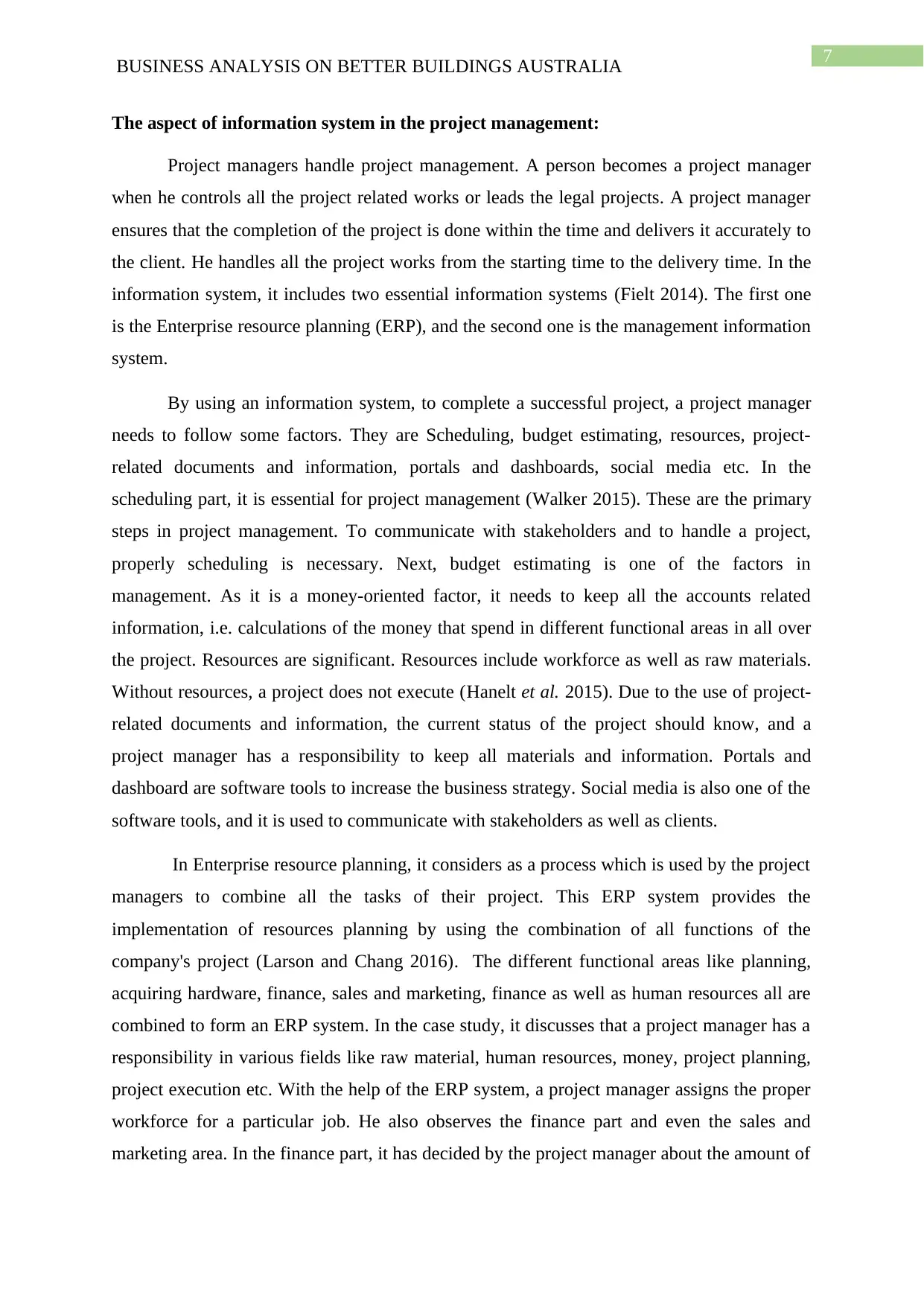
7
BUSINESS ANALYSIS ON BETTER BUILDINGS AUSTRALIA
The aspect of information system in the project management:
Project managers handle project management. A person becomes a project manager
when he controls all the project related works or leads the legal projects. A project manager
ensures that the completion of the project is done within the time and delivers it accurately to
the client. He handles all the project works from the starting time to the delivery time. In the
information system, it includes two essential information systems (Fielt 2014). The first one
is the Enterprise resource planning (ERP), and the second one is the management information
system.
By using an information system, to complete a successful project, a project manager
needs to follow some factors. They are Scheduling, budget estimating, resources, project-
related documents and information, portals and dashboards, social media etc. In the
scheduling part, it is essential for project management (Walker 2015). These are the primary
steps in project management. To communicate with stakeholders and to handle a project,
properly scheduling is necessary. Next, budget estimating is one of the factors in
management. As it is a money-oriented factor, it needs to keep all the accounts related
information, i.e. calculations of the money that spend in different functional areas in all over
the project. Resources are significant. Resources include workforce as well as raw materials.
Without resources, a project does not execute (Hanelt et al. 2015). Due to the use of project-
related documents and information, the current status of the project should know, and a
project manager has a responsibility to keep all materials and information. Portals and
dashboard are software tools to increase the business strategy. Social media is also one of the
software tools, and it is used to communicate with stakeholders as well as clients.
In Enterprise resource planning, it considers as a process which is used by the project
managers to combine all the tasks of their project. This ERP system provides the
implementation of resources planning by using the combination of all functions of the
company's project (Larson and Chang 2016). The different functional areas like planning,
acquiring hardware, finance, sales and marketing, finance as well as human resources all are
combined to form an ERP system. In the case study, it discusses that a project manager has a
responsibility in various fields like raw material, human resources, money, project planning,
project execution etc. With the help of the ERP system, a project manager assigns the proper
workforce for a particular job. He also observes the finance part and even the sales and
marketing area. In the finance part, it has decided by the project manager about the amount of
BUSINESS ANALYSIS ON BETTER BUILDINGS AUSTRALIA
The aspect of information system in the project management:
Project managers handle project management. A person becomes a project manager
when he controls all the project related works or leads the legal projects. A project manager
ensures that the completion of the project is done within the time and delivers it accurately to
the client. He handles all the project works from the starting time to the delivery time. In the
information system, it includes two essential information systems (Fielt 2014). The first one
is the Enterprise resource planning (ERP), and the second one is the management information
system.
By using an information system, to complete a successful project, a project manager
needs to follow some factors. They are Scheduling, budget estimating, resources, project-
related documents and information, portals and dashboards, social media etc. In the
scheduling part, it is essential for project management (Walker 2015). These are the primary
steps in project management. To communicate with stakeholders and to handle a project,
properly scheduling is necessary. Next, budget estimating is one of the factors in
management. As it is a money-oriented factor, it needs to keep all the accounts related
information, i.e. calculations of the money that spend in different functional areas in all over
the project. Resources are significant. Resources include workforce as well as raw materials.
Without resources, a project does not execute (Hanelt et al. 2015). Due to the use of project-
related documents and information, the current status of the project should know, and a
project manager has a responsibility to keep all materials and information. Portals and
dashboard are software tools to increase the business strategy. Social media is also one of the
software tools, and it is used to communicate with stakeholders as well as clients.
In Enterprise resource planning, it considers as a process which is used by the project
managers to combine all the tasks of their project. This ERP system provides the
implementation of resources planning by using the combination of all functions of the
company's project (Larson and Chang 2016). The different functional areas like planning,
acquiring hardware, finance, sales and marketing, finance as well as human resources all are
combined to form an ERP system. In the case study, it discusses that a project manager has a
responsibility in various fields like raw material, human resources, money, project planning,
project execution etc. With the help of the ERP system, a project manager assigns the proper
workforce for a particular job. He also observes the finance part and even the sales and
marketing area. In the finance part, it has decided by the project manager about the amount of
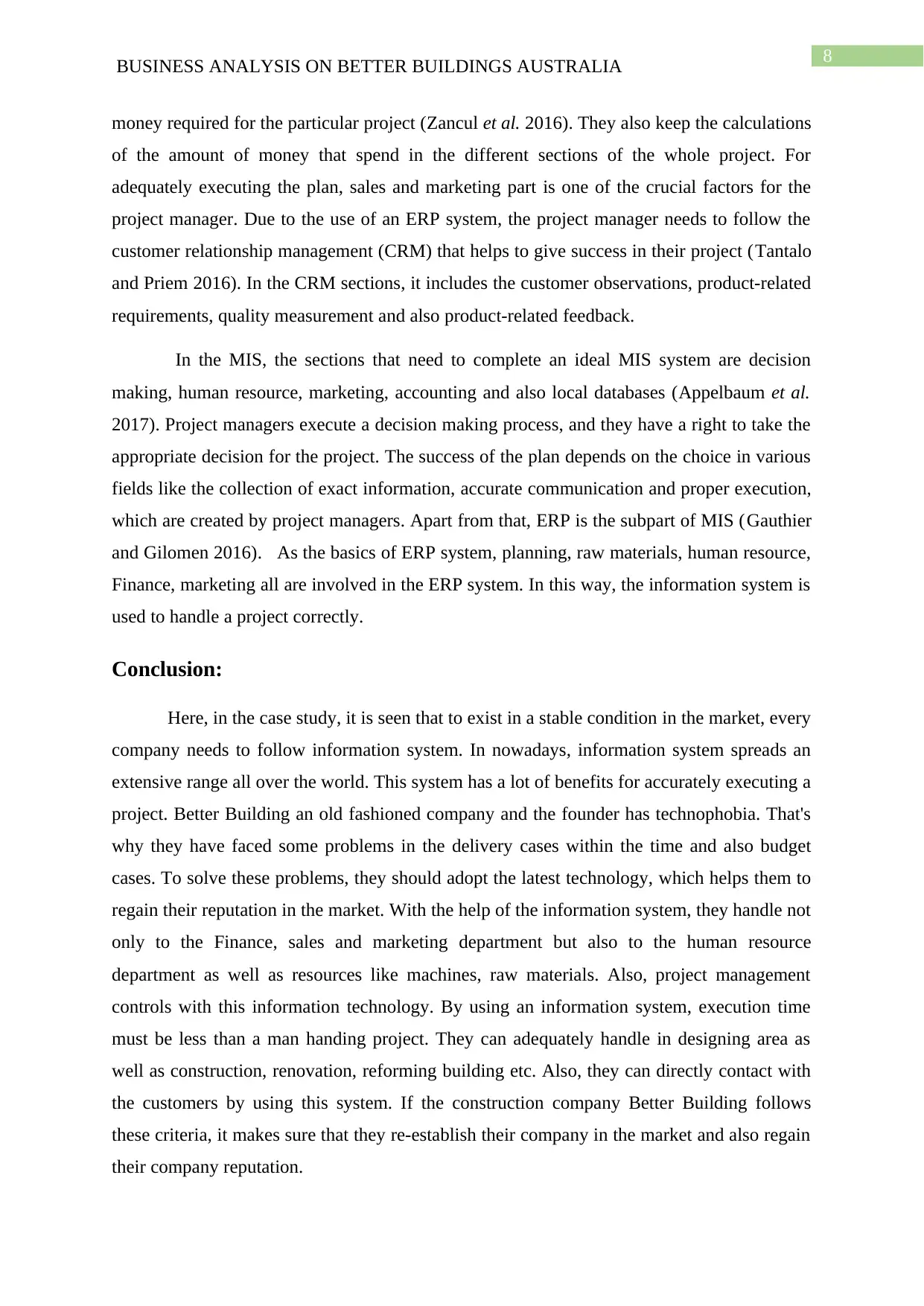
8
BUSINESS ANALYSIS ON BETTER BUILDINGS AUSTRALIA
money required for the particular project (Zancul et al. 2016). They also keep the calculations
of the amount of money that spend in the different sections of the whole project. For
adequately executing the plan, sales and marketing part is one of the crucial factors for the
project manager. Due to the use of an ERP system, the project manager needs to follow the
customer relationship management (CRM) that helps to give success in their project (Tantalo
and Priem 2016). In the CRM sections, it includes the customer observations, product-related
requirements, quality measurement and also product-related feedback.
In the MIS, the sections that need to complete an ideal MIS system are decision
making, human resource, marketing, accounting and also local databases (Appelbaum et al.
2017). Project managers execute a decision making process, and they have a right to take the
appropriate decision for the project. The success of the plan depends on the choice in various
fields like the collection of exact information, accurate communication and proper execution,
which are created by project managers. Apart from that, ERP is the subpart of MIS (Gauthier
and Gilomen 2016). As the basics of ERP system, planning, raw materials, human resource,
Finance, marketing all are involved in the ERP system. In this way, the information system is
used to handle a project correctly.
Conclusion:
Here, in the case study, it is seen that to exist in a stable condition in the market, every
company needs to follow information system. In nowadays, information system spreads an
extensive range all over the world. This system has a lot of benefits for accurately executing a
project. Better Building an old fashioned company and the founder has technophobia. That's
why they have faced some problems in the delivery cases within the time and also budget
cases. To solve these problems, they should adopt the latest technology, which helps them to
regain their reputation in the market. With the help of the information system, they handle not
only to the Finance, sales and marketing department but also to the human resource
department as well as resources like machines, raw materials. Also, project management
controls with this information technology. By using an information system, execution time
must be less than a man handing project. They can adequately handle in designing area as
well as construction, renovation, reforming building etc. Also, they can directly contact with
the customers by using this system. If the construction company Better Building follows
these criteria, it makes sure that they re-establish their company in the market and also regain
their company reputation.
BUSINESS ANALYSIS ON BETTER BUILDINGS AUSTRALIA
money required for the particular project (Zancul et al. 2016). They also keep the calculations
of the amount of money that spend in the different sections of the whole project. For
adequately executing the plan, sales and marketing part is one of the crucial factors for the
project manager. Due to the use of an ERP system, the project manager needs to follow the
customer relationship management (CRM) that helps to give success in their project (Tantalo
and Priem 2016). In the CRM sections, it includes the customer observations, product-related
requirements, quality measurement and also product-related feedback.
In the MIS, the sections that need to complete an ideal MIS system are decision
making, human resource, marketing, accounting and also local databases (Appelbaum et al.
2017). Project managers execute a decision making process, and they have a right to take the
appropriate decision for the project. The success of the plan depends on the choice in various
fields like the collection of exact information, accurate communication and proper execution,
which are created by project managers. Apart from that, ERP is the subpart of MIS (Gauthier
and Gilomen 2016). As the basics of ERP system, planning, raw materials, human resource,
Finance, marketing all are involved in the ERP system. In this way, the information system is
used to handle a project correctly.
Conclusion:
Here, in the case study, it is seen that to exist in a stable condition in the market, every
company needs to follow information system. In nowadays, information system spreads an
extensive range all over the world. This system has a lot of benefits for accurately executing a
project. Better Building an old fashioned company and the founder has technophobia. That's
why they have faced some problems in the delivery cases within the time and also budget
cases. To solve these problems, they should adopt the latest technology, which helps them to
regain their reputation in the market. With the help of the information system, they handle not
only to the Finance, sales and marketing department but also to the human resource
department as well as resources like machines, raw materials. Also, project management
controls with this information technology. By using an information system, execution time
must be less than a man handing project. They can adequately handle in designing area as
well as construction, renovation, reforming building etc. Also, they can directly contact with
the customers by using this system. If the construction company Better Building follows
these criteria, it makes sure that they re-establish their company in the market and also regain
their company reputation.
⊘ This is a preview!⊘
Do you want full access?
Subscribe today to unlock all pages.

Trusted by 1+ million students worldwide
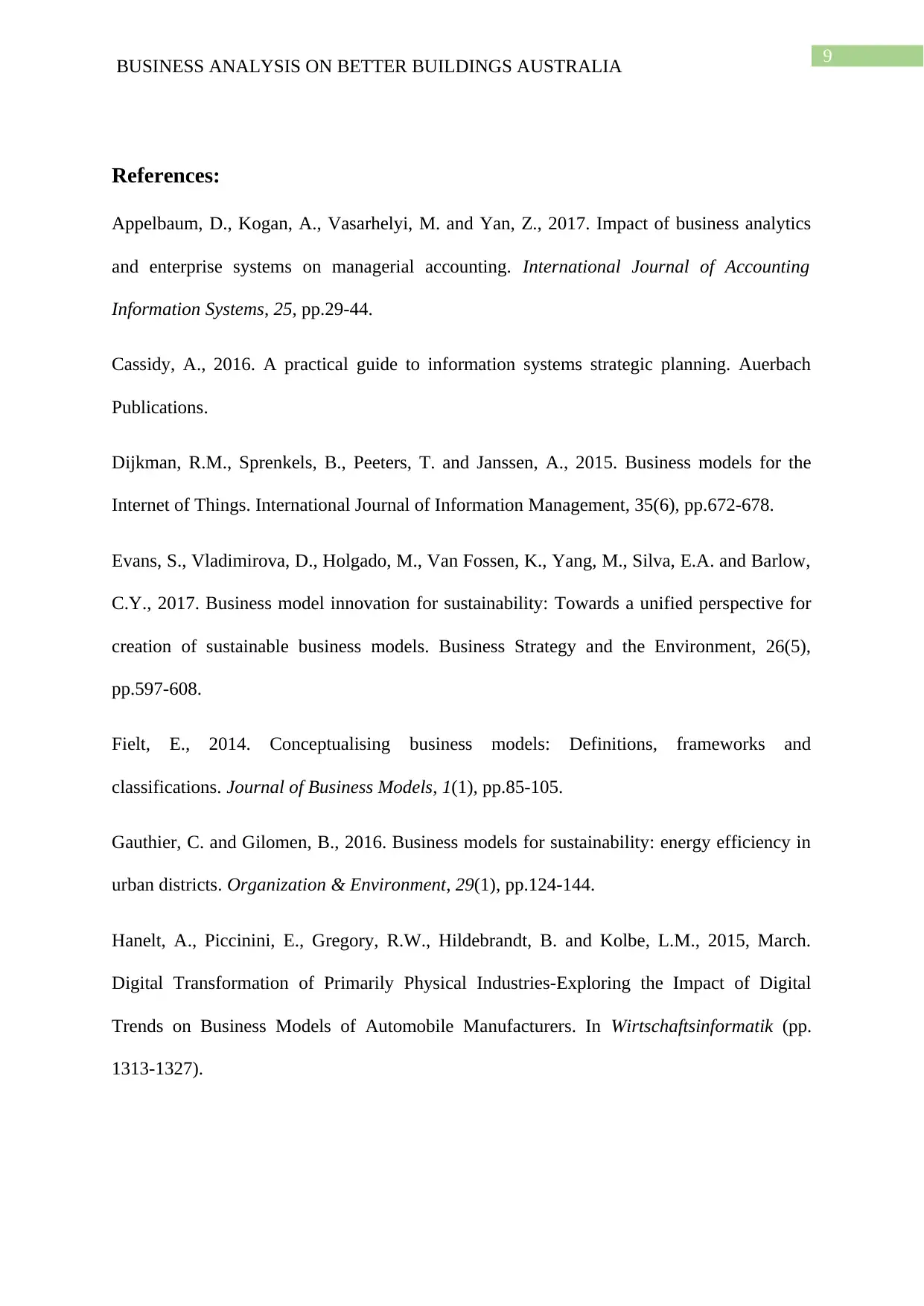
9
BUSINESS ANALYSIS ON BETTER BUILDINGS AUSTRALIA
References:
Appelbaum, D., Kogan, A., Vasarhelyi, M. and Yan, Z., 2017. Impact of business analytics
and enterprise systems on managerial accounting. International Journal of Accounting
Information Systems, 25, pp.29-44.
Cassidy, A., 2016. A practical guide to information systems strategic planning. Auerbach
Publications.
Dijkman, R.M., Sprenkels, B., Peeters, T. and Janssen, A., 2015. Business models for the
Internet of Things. International Journal of Information Management, 35(6), pp.672-678.
Evans, S., Vladimirova, D., Holgado, M., Van Fossen, K., Yang, M., Silva, E.A. and Barlow,
C.Y., 2017. Business model innovation for sustainability: Towards a unified perspective for
creation of sustainable business models. Business Strategy and the Environment, 26(5),
pp.597-608.
Fielt, E., 2014. Conceptualising business models: Definitions, frameworks and
classifications. Journal of Business Models, 1(1), pp.85-105.
Gauthier, C. and Gilomen, B., 2016. Business models for sustainability: energy efficiency in
urban districts. Organization & Environment, 29(1), pp.124-144.
Hanelt, A., Piccinini, E., Gregory, R.W., Hildebrandt, B. and Kolbe, L.M., 2015, March.
Digital Transformation of Primarily Physical Industries-Exploring the Impact of Digital
Trends on Business Models of Automobile Manufacturers. In Wirtschaftsinformatik (pp.
1313-1327).
BUSINESS ANALYSIS ON BETTER BUILDINGS AUSTRALIA
References:
Appelbaum, D., Kogan, A., Vasarhelyi, M. and Yan, Z., 2017. Impact of business analytics
and enterprise systems on managerial accounting. International Journal of Accounting
Information Systems, 25, pp.29-44.
Cassidy, A., 2016. A practical guide to information systems strategic planning. Auerbach
Publications.
Dijkman, R.M., Sprenkels, B., Peeters, T. and Janssen, A., 2015. Business models for the
Internet of Things. International Journal of Information Management, 35(6), pp.672-678.
Evans, S., Vladimirova, D., Holgado, M., Van Fossen, K., Yang, M., Silva, E.A. and Barlow,
C.Y., 2017. Business model innovation for sustainability: Towards a unified perspective for
creation of sustainable business models. Business Strategy and the Environment, 26(5),
pp.597-608.
Fielt, E., 2014. Conceptualising business models: Definitions, frameworks and
classifications. Journal of Business Models, 1(1), pp.85-105.
Gauthier, C. and Gilomen, B., 2016. Business models for sustainability: energy efficiency in
urban districts. Organization & Environment, 29(1), pp.124-144.
Hanelt, A., Piccinini, E., Gregory, R.W., Hildebrandt, B. and Kolbe, L.M., 2015, March.
Digital Transformation of Primarily Physical Industries-Exploring the Impact of Digital
Trends on Business Models of Automobile Manufacturers. In Wirtschaftsinformatik (pp.
1313-1327).
Paraphrase This Document
Need a fresh take? Get an instant paraphrase of this document with our AI Paraphraser
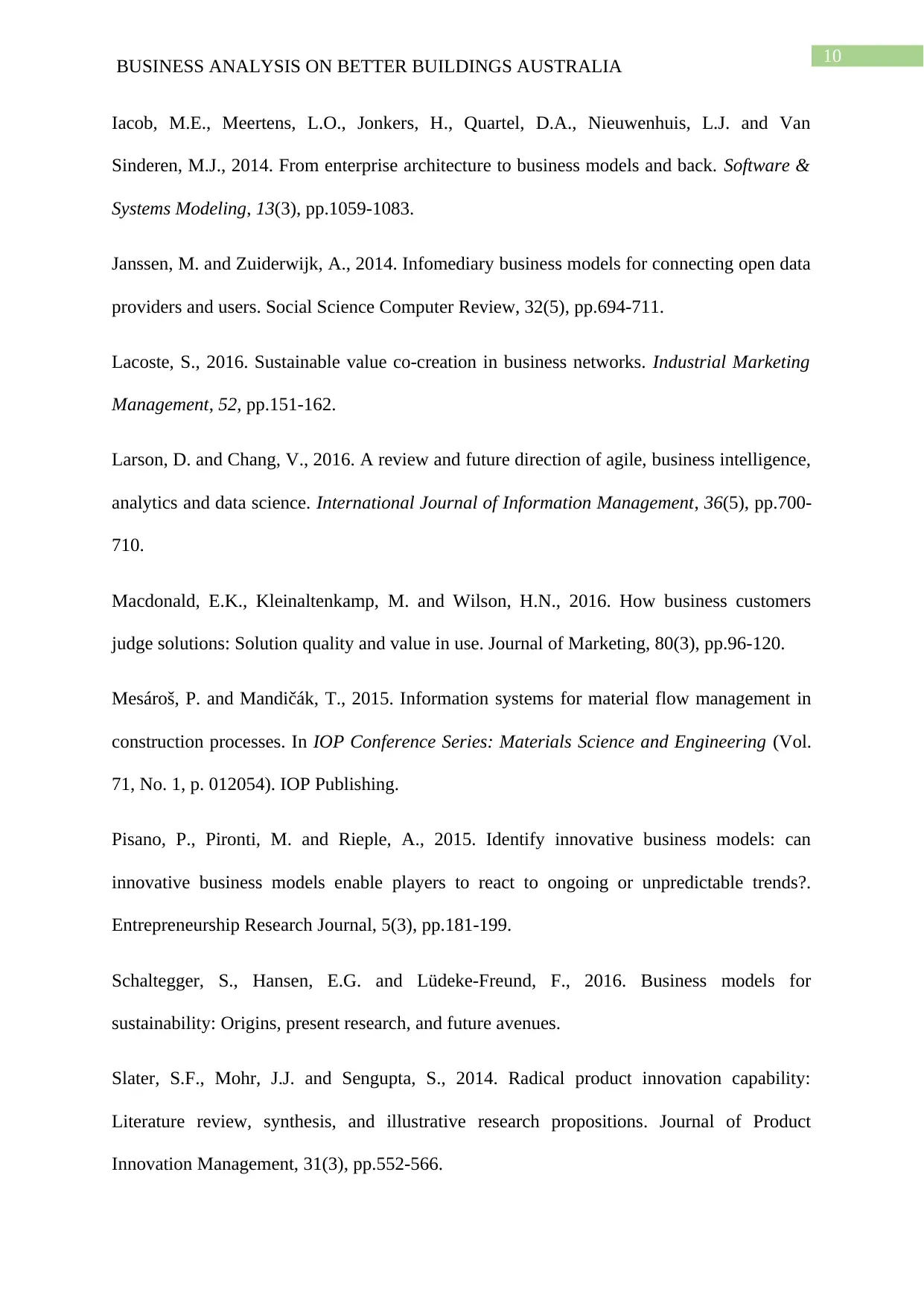
10
BUSINESS ANALYSIS ON BETTER BUILDINGS AUSTRALIA
Iacob, M.E., Meertens, L.O., Jonkers, H., Quartel, D.A., Nieuwenhuis, L.J. and Van
Sinderen, M.J., 2014. From enterprise architecture to business models and back. Software &
Systems Modeling, 13(3), pp.1059-1083.
Janssen, M. and Zuiderwijk, A., 2014. Infomediary business models for connecting open data
providers and users. Social Science Computer Review, 32(5), pp.694-711.
Lacoste, S., 2016. Sustainable value co-creation in business networks. Industrial Marketing
Management, 52, pp.151-162.
Larson, D. and Chang, V., 2016. A review and future direction of agile, business intelligence,
analytics and data science. International Journal of Information Management, 36(5), pp.700-
710.
Macdonald, E.K., Kleinaltenkamp, M. and Wilson, H.N., 2016. How business customers
judge solutions: Solution quality and value in use. Journal of Marketing, 80(3), pp.96-120.
Mesároš, P. and Mandičák, T., 2015. Information systems for material flow management in
construction processes. In IOP Conference Series: Materials Science and Engineering (Vol.
71, No. 1, p. 012054). IOP Publishing.
Pisano, P., Pironti, M. and Rieple, A., 2015. Identify innovative business models: can
innovative business models enable players to react to ongoing or unpredictable trends?.
Entrepreneurship Research Journal, 5(3), pp.181-199.
Schaltegger, S., Hansen, E.G. and Lüdeke-Freund, F., 2016. Business models for
sustainability: Origins, present research, and future avenues.
Slater, S.F., Mohr, J.J. and Sengupta, S., 2014. Radical product innovation capability:
Literature review, synthesis, and illustrative research propositions. Journal of Product
Innovation Management, 31(3), pp.552-566.
BUSINESS ANALYSIS ON BETTER BUILDINGS AUSTRALIA
Iacob, M.E., Meertens, L.O., Jonkers, H., Quartel, D.A., Nieuwenhuis, L.J. and Van
Sinderen, M.J., 2014. From enterprise architecture to business models and back. Software &
Systems Modeling, 13(3), pp.1059-1083.
Janssen, M. and Zuiderwijk, A., 2014. Infomediary business models for connecting open data
providers and users. Social Science Computer Review, 32(5), pp.694-711.
Lacoste, S., 2016. Sustainable value co-creation in business networks. Industrial Marketing
Management, 52, pp.151-162.
Larson, D. and Chang, V., 2016. A review and future direction of agile, business intelligence,
analytics and data science. International Journal of Information Management, 36(5), pp.700-
710.
Macdonald, E.K., Kleinaltenkamp, M. and Wilson, H.N., 2016. How business customers
judge solutions: Solution quality and value in use. Journal of Marketing, 80(3), pp.96-120.
Mesároš, P. and Mandičák, T., 2015. Information systems for material flow management in
construction processes. In IOP Conference Series: Materials Science and Engineering (Vol.
71, No. 1, p. 012054). IOP Publishing.
Pisano, P., Pironti, M. and Rieple, A., 2015. Identify innovative business models: can
innovative business models enable players to react to ongoing or unpredictable trends?.
Entrepreneurship Research Journal, 5(3), pp.181-199.
Schaltegger, S., Hansen, E.G. and Lüdeke-Freund, F., 2016. Business models for
sustainability: Origins, present research, and future avenues.
Slater, S.F., Mohr, J.J. and Sengupta, S., 2014. Radical product innovation capability:
Literature review, synthesis, and illustrative research propositions. Journal of Product
Innovation Management, 31(3), pp.552-566.
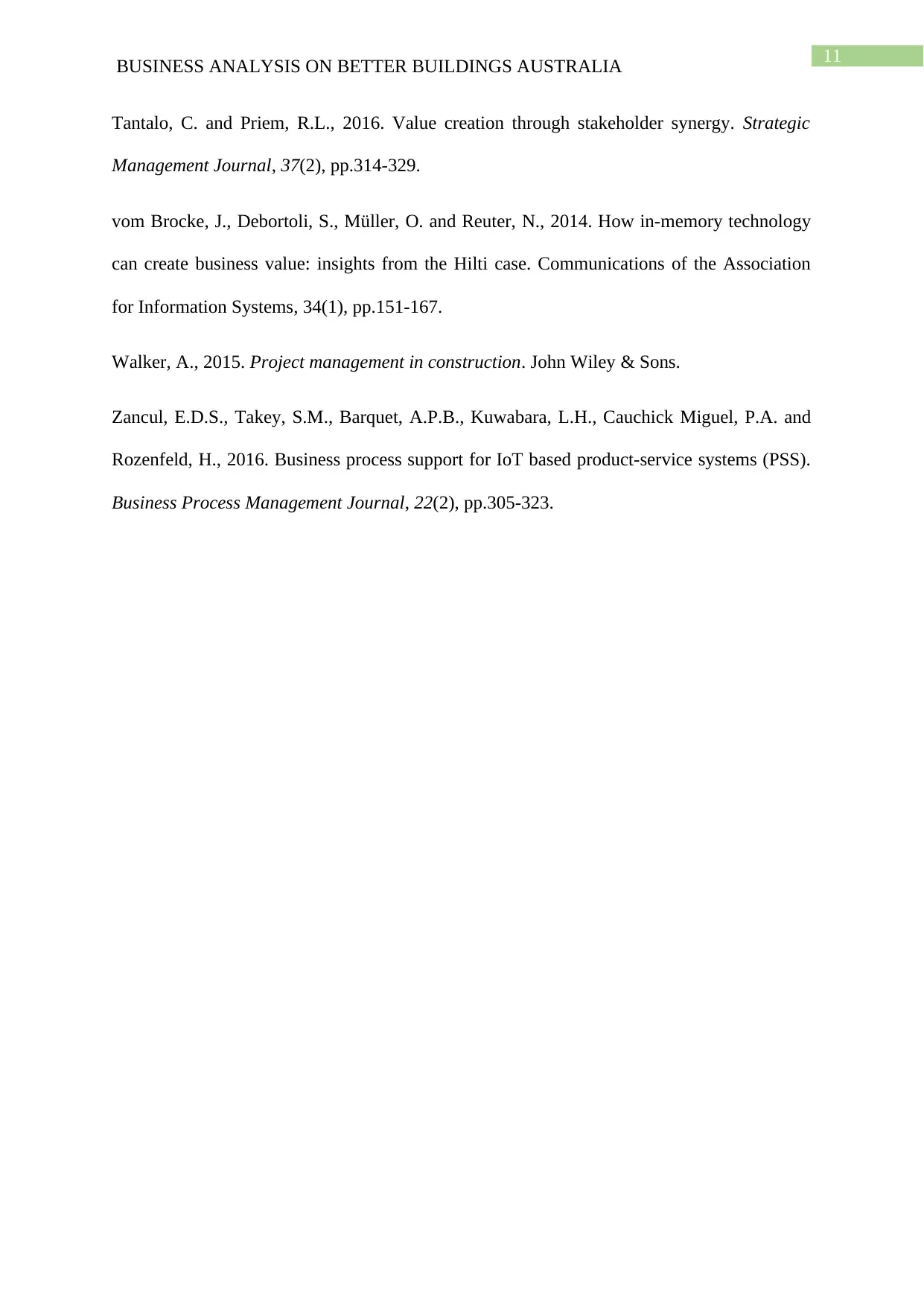
11
BUSINESS ANALYSIS ON BETTER BUILDINGS AUSTRALIA
Tantalo, C. and Priem, R.L., 2016. Value creation through stakeholder synergy. Strategic
Management Journal, 37(2), pp.314-329.
vom Brocke, J., Debortoli, S., Müller, O. and Reuter, N., 2014. How in-memory technology
can create business value: insights from the Hilti case. Communications of the Association
for Information Systems, 34(1), pp.151-167.
Walker, A., 2015. Project management in construction. John Wiley & Sons.
Zancul, E.D.S., Takey, S.M., Barquet, A.P.B., Kuwabara, L.H., Cauchick Miguel, P.A. and
Rozenfeld, H., 2016. Business process support for IoT based product-service systems (PSS).
Business Process Management Journal, 22(2), pp.305-323.
BUSINESS ANALYSIS ON BETTER BUILDINGS AUSTRALIA
Tantalo, C. and Priem, R.L., 2016. Value creation through stakeholder synergy. Strategic
Management Journal, 37(2), pp.314-329.
vom Brocke, J., Debortoli, S., Müller, O. and Reuter, N., 2014. How in-memory technology
can create business value: insights from the Hilti case. Communications of the Association
for Information Systems, 34(1), pp.151-167.
Walker, A., 2015. Project management in construction. John Wiley & Sons.
Zancul, E.D.S., Takey, S.M., Barquet, A.P.B., Kuwabara, L.H., Cauchick Miguel, P.A. and
Rozenfeld, H., 2016. Business process support for IoT based product-service systems (PSS).
Business Process Management Journal, 22(2), pp.305-323.
⊘ This is a preview!⊘
Do you want full access?
Subscribe today to unlock all pages.

Trusted by 1+ million students worldwide
1 out of 12
Related Documents
Your All-in-One AI-Powered Toolkit for Academic Success.
+13062052269
info@desklib.com
Available 24*7 on WhatsApp / Email
![[object Object]](/_next/static/media/star-bottom.7253800d.svg)
Unlock your academic potential
Copyright © 2020–2025 A2Z Services. All Rights Reserved. Developed and managed by ZUCOL.




